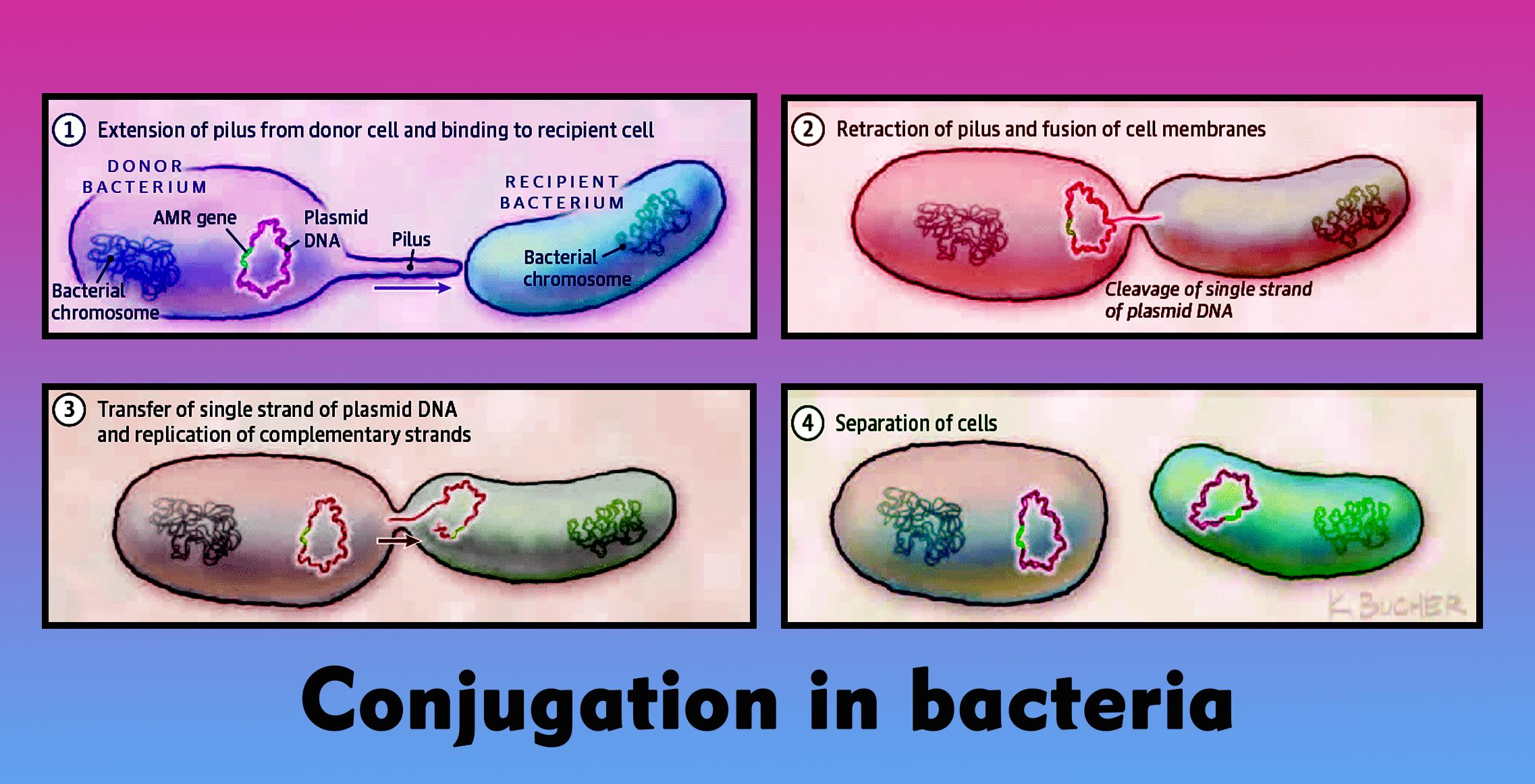
Answer
441.6k+ views
Hint: Bacteria are prokaryotes minute organisms that reproduce mainly by asexual reproduction. Sexual reproduction in bacteria is of the special type where the fusion of gamete doesn't take place, sexual reproduction takes place by genetic combination.
Complete Answer:
In the case of sexual reproduction, bacteria show parasexuality where genetic combination and recombination take place. The simple form of sexual reproduction in bacteria takes place by conjugation which was first discovered by Lederberg and Tatum in 1946 in Escherichia coli. In the conjugation donor is male whereas the recipient is female, the male cell consists of a fertility factor in its plasmid whereas the female cell lacks the fertility factor. After the division of plasmid in the male cell, the pili of the cell form a conjugation tube by which the transfer of one plasmid takes place from male cell to female cell, and this new female cell will act as a donor cell.
Additional information: Transformation and transduction is also a type of asexual reproduction, in transformation gene transfer take place from dead bacteria to newly formed bacteria, transformation is carried out by scientist in lab condition to identify nature of bacteria. Transduction carried out by bacteriophage where the transfer of gene takes place from one bacteria to another bacteria.

Asexual reproduction in bacteria takes place by binary fission. In a binary fission cell, multiply and divide to form a new cell, this type of division is called an amitotic division where the spindle doesn't form. In binary fission, the nucleoid and chromosome replicate, and after replication, the cell divides to form two new daughter cells, this division takes place by the development of turgor in both cells.
In the case of spore-producing bacteria, reproduction takes place by sporulation. In bacteria, endospore is formed by dehydration of the nuclear body which secretes the cell wall, after autolysis endospore disperse and germinate to form new bacteria. Endospore can tolerate high temperatures, drought, and toxic chemicals but endospore formation is rare in bacteria.
So, the correct answer is ‘(e) Conjugation’.
Note: Reproduction in bacteria shows that bacterias are immortal because one bacteria divides and forms two bacteria which on the further division lead to the formation of numbers of bacteria. Death in bacteria only takes place by environmental change, accumulation of waste products, and by bacteriophages.
Complete Answer:
In the case of sexual reproduction, bacteria show parasexuality where genetic combination and recombination take place. The simple form of sexual reproduction in bacteria takes place by conjugation which was first discovered by Lederberg and Tatum in 1946 in Escherichia coli. In the conjugation donor is male whereas the recipient is female, the male cell consists of a fertility factor in its plasmid whereas the female cell lacks the fertility factor. After the division of plasmid in the male cell, the pili of the cell form a conjugation tube by which the transfer of one plasmid takes place from male cell to female cell, and this new female cell will act as a donor cell.
Additional information: Transformation and transduction is also a type of asexual reproduction, in transformation gene transfer take place from dead bacteria to newly formed bacteria, transformation is carried out by scientist in lab condition to identify nature of bacteria. Transduction carried out by bacteriophage where the transfer of gene takes place from one bacteria to another bacteria.

Asexual reproduction in bacteria takes place by binary fission. In a binary fission cell, multiply and divide to form a new cell, this type of division is called an amitotic division where the spindle doesn't form. In binary fission, the nucleoid and chromosome replicate, and after replication, the cell divides to form two new daughter cells, this division takes place by the development of turgor in both cells.
In the case of spore-producing bacteria, reproduction takes place by sporulation. In bacteria, endospore is formed by dehydration of the nuclear body which secretes the cell wall, after autolysis endospore disperse and germinate to form new bacteria. Endospore can tolerate high temperatures, drought, and toxic chemicals but endospore formation is rare in bacteria.
So, the correct answer is ‘(e) Conjugation’.
Note: Reproduction in bacteria shows that bacterias are immortal because one bacteria divides and forms two bacteria which on the further division lead to the formation of numbers of bacteria. Death in bacteria only takes place by environmental change, accumulation of waste products, and by bacteriophages.
Recently Updated Pages
10 Examples of Evaporation in Daily Life with Explanations

10 Examples of Diffusion in Everyday Life

1 g of dry green algae absorb 47 times 10 3 moles of class 11 chemistry CBSE

What is the meaning of celestial class 10 social science CBSE

What causes groundwater depletion How can it be re class 10 chemistry CBSE

Under which different types can the following changes class 10 physics CBSE

Trending doubts
Fill the blanks with the suitable prepositions 1 The class 9 english CBSE

Which are the Top 10 Largest Countries of the World?

How do you graph the function fx 4x class 9 maths CBSE

Differentiate between homogeneous and heterogeneous class 12 chemistry CBSE

Difference between Prokaryotic cell and Eukaryotic class 11 biology CBSE

Change the following sentences into negative and interrogative class 10 english CBSE

The Equation xxx + 2 is Satisfied when x is Equal to Class 10 Maths

Why is there a time difference of about 5 hours between class 10 social science CBSE

Give 10 examples for herbs , shrubs , climbers , creepers




